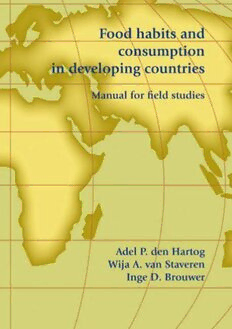
Food Habits And Consumption In Developing Countries: Manual for Field Studies PDF
Preview Food Habits And Consumption In Developing Countries: Manual for Field Studies
Food habits and consumption in developing countries Manual for fi eld studies Adel P. den Hartog Wija A. van Staveren Inge D. Brouwer Food habits and consumption in developing countries Food habits and consumption in developing countries Manual for field studies Adel P. den Hartog Wija A. van Staveren Inge D. Brouwer Wageningen Academic P u b l i s h e r s All rights reserved. Nothing from this public ation may be reproduced, stored in a computerised system or published in any form or in any manner, including electronic, mechanical, reprographic or photographic, without prior written permission from the publisher, Wageningen ISBN: 978-90-76998-94-7 Academic Publishers, P.O. Box 220, NL-6700 AE e-ISBN: 978-90-8686-667-0 Wageningen, The Netherlands. DOI: 10.3920/978-90-8686-667-0 The individual contributions in this publication and any liabilities arising from them remain the First published, 2006 responsibility of the authors. The publisher is not responsible for possible © Wageningen Academic Publishers damages, which could be a result of content The Netherlands, 2006 derived from this publication. Preface This manual addresses food habits and consumption patterns in developing and emerging countries to better understand the nutritional situation of their populations. It comprises practical information on conducting field studies. Part One of the manual provides insight into the dynamics of food habits and consumption and the accompanying socio-economic and cultural dimensions. Part Two gives practical information on conducting small-scale studies to be carried out within the framework of a nutrition issue, including the collection of data on food habits and the measurement of food intake. This manual on food habits and consumption is intended for professionals with practical or academic training and who are involved in various types of food and nutrition programmes and related activities. It can also be used as a handbook in food and nutrition training courses at professional and academic levels. The first manual on food habits and consumption was published in 1983 by Pudoc in Wageningen and was updated in 1988 and 1995 by Margraf Verlag in Germany. During the last decade, the food and nutrition situation in the developing world has changed dramatically and new ideas and insights on food and nutrition issues have emerged. Thus, the need arose to write a complete new manual based on new evidence and insights. The material presented is further based on the experiences of the authors while working with the Division of Human Nutrition of the Wageningen University and Research Centre, WUR, Netherlands, bilateral programmes in the field of research and training, and international agencies such as FAO and UNICEF. Many thanks are due to those who have helped in preparing the manual, in particular Mr Michael Price (editorial work), Ms Janneke van Wijngaarden (technical support), Mr Jan Burema (statistical advice), and the staff of Wageningen International (formerly IAC) of the WUR. The publication of the manual would not have been possible without the generous support of the Dutch foundation Stichting voor Sociale en Culturele Solidariteit in Zeist, founded by the late Dr. Ir. F.D. Tollenaar, food scientist (1915-1999). Adel P. den Hartog Food habits and consumption in developing countries 7 Table of contents Preface 7 PART ONE: FOOD HABITS, FOOD CULTURE, AND CONSUMPTION 1. Introduction 15 1.1 The nutritional context 15 1.2 Aim of the manual 17 2. Food culture 19 2.1 Food culture: What is food? 19 2.2 Food avoidances or food taboos 20 2.3 Food classification systems 23 2.4 Social role of food in society 25 2.5 Gastronomic meaning 25 2.6 Means of cultural identity 26 2.7 Religious or magic meaning 27 2.8 Food as means of communication 28 2.9 Food as expression of status and distinction 28 2.10 Means of influence and power 29 2.11 Means of exchange 29 3. Geographical dimensions of food 31 3.1 Dietary patterns and their links with geographical zones 31 3.2 Dairy and the geographical context 33 3.3 The changing place of dairying 34 3.4 Food diffusion and globalization 36 3.5 Acceptance of new foods 38 4. Nutrition in transition 43 4.1 Urbanization: nutrition in transition 43 4.2 Street food 50 4.3 Urban agriculture 53 Food habits and consumption in developing countries 9
